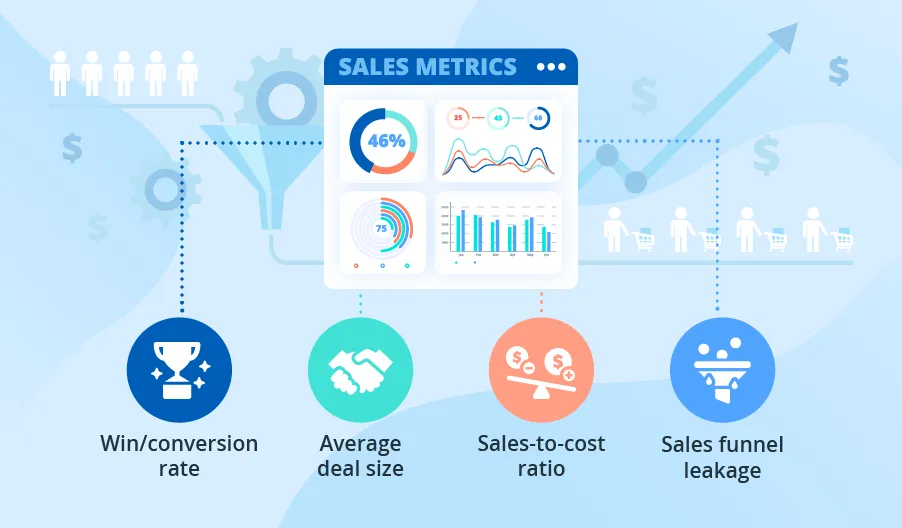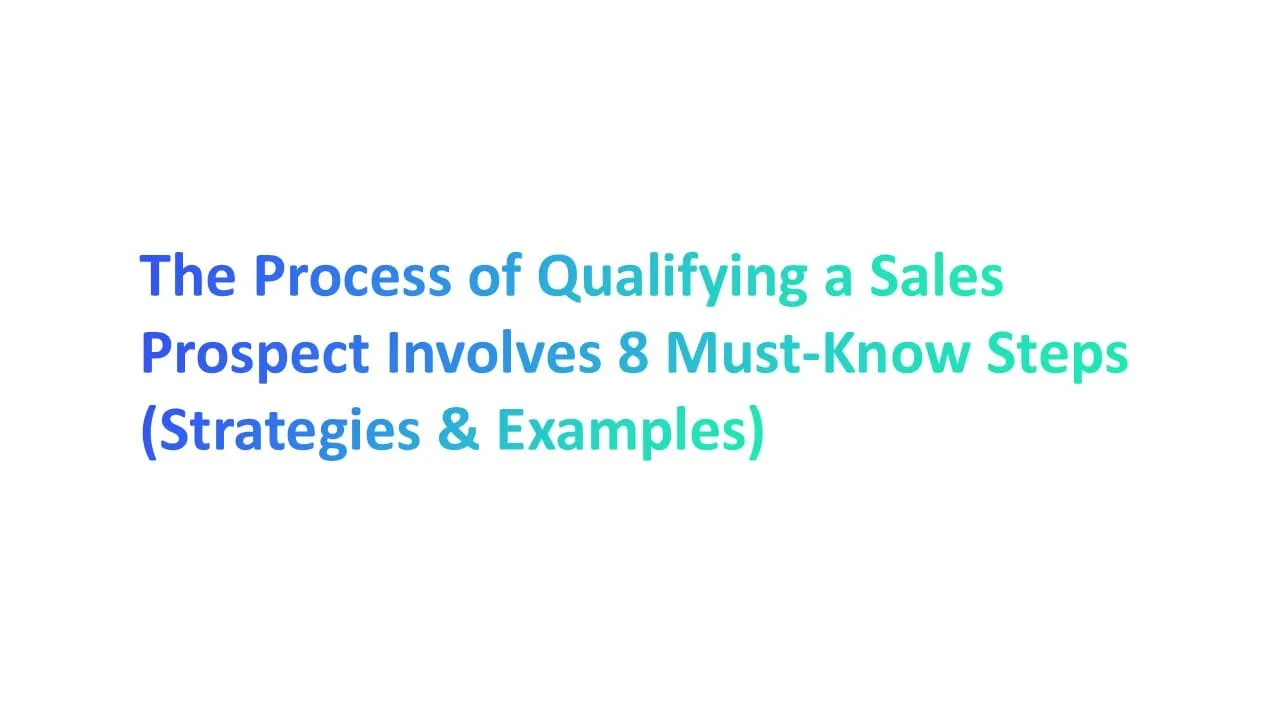Implementing effective sales management techniques is crucial for enhancing your sales team's performance and achieving your sales targets. In fact, companies that utilize structured sales management processes can see up to a 28% increase in their sales performance. By focusing on actionable strategies, sales managers can guide their sales teams more effectively.
This article will explore nine practical techniques to help your team excel and consistently meet your goals.
What Is Sales Management?

Sales management is the process of planning, executing, and analyzing strategies to help a sales department meet its sales objectives. It involves guiding sales professionals, tracking sales pipeline progress, and using sales management tools to improve efficiency.
A well-structured sales management system ensures smooth sales operations and aligns efforts with business goals. Sales staff and sales representatives rely on structured processes to manage customer relationships and close deals.
Sales leadership plays a key role in setting key performance indicators and monitoring sales volume to drive successful sales while maintaining a positive team culture for the entire team.
What is the Importance of Sales Management?

Effective sales management strategy plays a crucial role in shaping a company’s growth. It helps organizations track sales activities, streamline operations, and guide sales reps toward achieving business objectives.
By using structured processes, businesses can drive revenue and improve team efficiency.
1. Drives Revenue Growth
A strong sales management strategy ensures that every deal contributes to business growth. By monitoring sales reports, companies can identify trends and make informed decisions.
A well-organized sales organization allows managers to allocate resources efficiently, helping teams meet revenue targets.
2. Improves Sales Team Efficiency
With clear processes in place, sales team productivity increases. A good sales management system eliminates unnecessary delays and organizes workflows.
Tracking sales calls and evaluating customer data allows managers to identify areas of improvement, ensuring that every interaction adds value.
3. Enhances Customer Relationships
Successful businesses know that strong customer interactions lead to repeat sales. By managing sales team members effectively, companies can ensure that customer concerns are addressed promptly.
Understanding sales manager’s job responsibilities helps maintain high service standards.
4. Ensures Consistent Sales Processes
A structured sales management strategy helps maintain consistency in operations. Regular sales management tips provide guidance on handling challenges.
Using social media management tools, teams can stay engaged with prospects and build lasting relationships.
5. Helps Set and Achieve Sales Targets
Setting clear sales targets is essential for tracking progress. By monitoring the sales team’s progress, managers can ensure that goals are met efficiently.
A strong lead generation process brings in quality prospects, increasing the chances of conversions.
6. Optimizes Sales Strategies with Data
Data-driven decision-making improves sales success rates. Businesses that focus on measuring sales performance can refine their approaches and adjust strategies based on real-time insights.
Proper analysis of sales management roles ensures every team member contributes effectively.
7. Improves Team Motivation and Retention
A motivated team performs better. Encouraging professional development and tracking sales efforts help managers create an engaging work environment.
Recognizing achievements leads to a higher retention rate among employees.
8. Aligns Sales with Business Goals
A well-defined business development plan aligns sales efforts with long-term objectives. A sales director ensures that the company stays on track while coordinating operations between different departments.
Analyzing future sales trends allows businesses to adapt to market changes and maintain steady growth.
Effective sales management strategy is more than just meeting quotas—it ensures sustainable growth, structured operations, and stronger customer connections.
Step-by-Step Breakdown of the Sales Management Process

Step 1. Establish Clear Sales Goals and KPIs
Setting clear goals is the foundation of successful sales management. It ensures that sales teams have measurable targets and a structured approach to track performance. Defining key performance indicators (KPIs) helps managers assess progress and make data-driven decisions.
How to do it
- Set realistic and achievable sales goals based on past performance.
- Define KPIs that align with business objectives.
- Monitor progress regularly and adjust goals as needed.
Step 2. Define and Document Sales Processes
A structured effective sales management process helps teams work efficiently and stay aligned. By documenting each stage, managers can provide clear guidelines for handling leads, following up, and closing deals.
How to do it
- Map out each step of the sales journey.
- Create a standardized process for lead management and follow-ups.
- Use documentation to train new hires effectively.
Step 3. Structure the Sales Team Effectively
Organizing the sales team properly ensures that each member plays a specific role in achieving targets. A well-structured sales force helps improve coordination and accountability.
How to do it
- Assign roles based on individual strengths and experience.
- Divide responsibilities between prospecting, closing, and account management.
- Implement a reporting system to track each team member’s contributions.
Step 4. Implement Lead Qualification and Management
Not all leads are worth pursuing. A clear lead qualification process helps sales teams focus on potential customers who are most likely to convert.
How to do it
- Define lead qualification criteria based on company goals.
- Use data-driven insights to identify high-value prospects.
- Implement follow-up strategies to nurture leads effectively.
Step 5. Develop Effective Sales Strategies
A strong enterprise sales management approach requires well-defined strategies to close deals efficiently. Sales teams need clear methods for engaging with different types of buyers.
How to do it
- Identify the best outreach techniques for different customer segments.
- Develop personalized sales pitches based on customer needs.
- Continuously refine strategies based on sales performance data.
Step 6. Establish a Sales Performance Monitoring System
Tracking performance is key to improving results. A structured monitoring system allows managers to measure progress and adjust strategies accordingly.
How to do it
- Set up performance tracking tools and dashboards.
- Conduct regular performance reviews with the team.
- Use real-time data to identify areas for improvement.
Step 7. Optimize Communication and Collaboration
A well-connected team achieves better results. Open communication ensures that sales professionals share insights and work towards common goals.
How to do it
- Encourage regular team meetings and discussions.
- Use internal tools to facilitate communication between team members.
- Provide clear updates on sales objectives and strategies.
Step 8. Strengthen Customer Relationship Management (CRM)
Effective saas sales management relies on maintaining strong relationships with existing customers. A structured approach to CRM increases customer satisfaction and retention.
How to do it
- Implement a CRM system to manage customer interactions.
- Follow up with customers to ensure long-term engagement.
- Analyze customer data to personalize future sales efforts.
Step 9. Continuously Improve Through Data-Driven Insights
Sales strategies should evolve based on real-time insights. Regular sales analysis helps businesses refine their approaches and stay competitive.
How to do it
- Analyze sales reports and customer feedback.
- Identify trends and adjust strategies accordingly.
- Invest in ongoing training to keep the sales team updated.
By following these structured steps, businesses can establish a great sales manager approach that enhances productivity and drives sustainable growth. Each step builds on the next, ensuring that teams are well-equipped to meet their goals efficiently.
9 Actionable Sales Management Techniques to Improve Performance

1. Leverage Data-Driven Sales Coaching
Sales coaching should be based on real insights rather than assumptions. Using sales data helps managers identify strengths, address weaknesses, and refine strategies.
How to Use Data for Coaching
- Track individual and team performance metrics.
- Identify patterns in successful sales calls.
- Provide targeted feedback based on sales trends.
- Use real examples to guide reps through improvements.
2. Implement Effective Sales Forecasting Methods
Predicting future sales helps businesses make better decisions. Accurate forecasting ensures that teams stay prepared for demand fluctuations.
Steps for Accurate Forecasting
- Analyze past sales data to identify trends.
- Use predictive analytics tools for better accuracy.
- Adjust forecasts based on market conditions.
- Set realistic goals based on data insights.
3. Streamline Deal Management for Faster Closures
A slow sales process can lead to lost opportunities. Simplifying deal management allows reps to close deals more efficiently.
Ways to Speed Up Closures
- Set clear deal progression stages.
- Reduce unnecessary steps in the approval process.
- Use digital contracts and e-signatures for faster transactions.
- Automate administrative tasks to free up selling time.
4. Personalize Sales Approaches Based on Buyer Behavior
Understanding how buyers interact with products or services allows for a more effective sales approach. Personalization increases engagement and improves conversion rates.
Tactics for Personalization
- Segment prospects based on industry, needs, and behavior.
- Customize pitches to align with buyer pain points.
- Use previous interactions to guide future conversations.
- Offer tailored solutions instead of generic sales scripts.
5. Use AI and Automation to Reduce Manual Tasks
AI tools can handle repetitive tasks, allowing sales teams to focus on closing deals and building relationships.
Tasks AI Can Handle
- Automate email follow-ups and reminders.
- Analyze customer interactions for insights.
- Score leads based on their likelihood to convert.
- Schedule meetings and manage calendars.
6. Create a Structured Sales Training Program
A well-structured training program ensures that all team members understand the sales process and perform at their best.
Key Training Elements
- Standardize onboarding for new hires.
- Provide regular skill-building sessions.
- Use role-playing exercises for real-world practice.
- Keep training materials updated with new trends.
7. Improve Follow-Up Strategies for Higher Conversions
Following up with prospects at the right time can make a significant difference in conversion rates.
Best Practices for Follow-Ups
- Set reminders for timely check-ins.
- Use multiple communication channels (email, calls, social media).
- Offer value in each follow-up instead of just asking for a decision.
- Track responses and adjust the approach based on engagement.
8. Develop Incentive Programs to Drive Performance
Sales teams perform better when they are rewarded for their efforts. A well-designed incentive program keeps motivation high.
Effective Incentive Ideas
- Offer tiered bonuses based on performance.
- Recognize top performers publicly.
- Provide non-monetary rewards like extra time off.
- Align incentives with company goals and values.
9. Continuously Test and Optimize Sales Strategies
Sales strategies should evolve based on performance data and market conditions. Regular testing helps teams refine their approaches.
How to Optimize Sales Strategies
- Run A/B tests on different sales tactics.
- Collect feedback from both sales teams and customers.
- Analyze results to find the most effective techniques.
- Adjust strategies based on ongoing performance metrics.
By applying these techniques, sales teams can improve efficiency, increase conversions, and create a more structured approach to selling.
How Can Sales Management Software Help Your Team?

Sales management software makes everyday tasks easier and helps sales teams work more efficiently.
It simplifies processes, improves tracking, and provides useful insights that help businesses make better decisions. Let’s explore how it adds value to a sales team.
1. Automates Sales Tasks
Repetitive manual tasks take up valuable time that sales reps could use to connect with potential customers. Sales management software helps by automating many of these tasks, allowing teams to focus on selling.
What It Can Automate
- Sending follow-up emails and reminders.
- Assigning leads based on predefined criteria.
- Updating records after each customer interaction.
- Generating reports without manual data entry.
By reducing the time spent on administrative work, sales teams can handle more prospects and close deals faster.
2. Improves Lead Tracking
Keeping track of multiple leads at different stages can get messy. Sales management software organizes leads in a structured way, making it easier to manage follow-ups and conversions.
How It Helps with Lead Tracking
- Automatically captures lead information from forms, emails, and calls.
- Shows the status of each lead in a clear sales pipeline.
- Sends alerts when a follow-up is due.
- Prioritizes leads based on their engagement level.
This ensures no lead is forgotten, and sales reps can engage with potential customers at the right time.
3. Enhances Sales Forecasting
Predicting future sales helps businesses plan ahead. Sales management software analyzes past data and current trends to provide more accurate forecasts.
Ways It Improves Forecasting
- Uses historical data to predict future sales trends.
- Identifies patterns that impact revenue growth.
- Helps managers set realistic targets.
- Provides a visual representation of expected sales numbers.
With accurate forecasting, businesses can prepare better and avoid last-minute surprises.
4. Integrates with CRM
A well-connected system improves efficiency. Sales management software integrates with customer relationship management (CRM) tools, allowing teams to access all customer details in one place.
Benefits of CRM Integration
- Stores all customer interactions in a single platform.
- Reduces duplicate data entry across systems.
- Helps sales reps personalize their approach with past insights.
- Improves coordination between sales and customer support teams.
This ensures that every team member has the information they need to maintain strong relationships with customers.
5. Provides Real-Time Insights
Data is only useful if it’s accessible at the right time. Sales management software gives managers and reps real-time insights into sales activities, helping them make quick and informed decisions.
How It Delivers Insights
- Tracks live sales performance data.
- Highlights areas that need attention.
- Shows team productivity and deal status.
- Provides instant access to reports and dashboards.
With real-time updates, sales teams can react faster to opportunities and challenges.
Sales management software helps teams work smarter by automating tasks, improving lead tracking, enhancing forecasting, integrating with CRM tools, and providing real-time insights. Businesses that use the right tools can improve efficiency, make better decisions, and create a more structured sales process.
How Can Sales Managers Motivate and Train Their Teams?

Keeping a sales team motivated and well-trained is key to improving performance. A strong approach to leadership helps teams stay engaged, learn continuously, and work towards common goals. Here’s how sales managers can create a productive and supportive work environment.
1. Set Clear Goals and Growth Paths
Sales reps perform better when they know what’s expected of them and how they can grow in their careers. Setting clear goals gives them direction and purpose.
Ways to Define Goals
- Break long-term targets into smaller, achievable milestones.
- Provide a clear path for career advancement.
- Offer guidance on skills needed for promotion.
2. Use Gamification for Engagement
Making work more interactive keeps sales teams motivated. Gamification adds friendly competition and encourages performance.
Simple Gamification Ideas
- Create leaderboards for tracking progress.
- Set challenges with small rewards.
- Use team-based competitions to encourage collaboration.
3. Provide Ongoing Training
Training shouldn’t stop after onboarding. Regular skill-building keeps sales teams sharp and adaptable.
How to Implement Continuous Training
- Offer short training sessions on new sales techniques.
- Provide access to learning resources like webinars or courses.
- Use real-world scenarios for hands-on practice.
4. Recognize and Reward Performance
Acknowledging effort keeps morale high. Recognition doesn’t always have to be monetary—small gestures can go a long way.
Ways to Reward Sales Teams
- Highlight achievements in team meetings.
- Offer flexible incentives, like extra time off.
- Celebrate milestones with personalized rewards.
5. Encourage Peer Learning
Sales reps can learn a lot from each other’s experiences. Creating a culture of knowledge sharing benefits the entire team.
Ways to Promote Peer Learning
- Set up mentorship programs within the team.
- Hold regular knowledge-sharing sessions.
- Encourage experienced reps to guide new hires.
6. Build a Positive Team Environment
A healthy work environment makes sales reps more engaged and productive. Sales managers play a big role in shaping team culture.
Ways to Improve Team Dynamics
- Encourage open communication and feedback.
- Organize team-building activities.
- Support a healthy work-life balance.
By setting clear goals, keeping training ongoing, and creating a positive work environment, sales managers can help their teams stay motivated, engaged, and ready to perform at their best.
What Are the Key Metrics to Track in Sales Management?

Tracking the right metrics helps sales teams understand their performance and make better decisions. These key indicators show where improvements are needed and how well strategies are working.
This measures how many leads turn into paying customers. A high conversion rate means the sales process is effective.
How to Track It:
- Compare the number of closed deals to total leads.
- Identify stages where prospects drop off.
2. Customer Acquisition Cost (CAC)
CAC shows how much it costs to acquire a new customer. Keeping this number low helps businesses stay profitable.
How to Track It:
- Add up marketing and sales expenses.
- Divide by the number of new customers in a set period.
3. Sales Cycle Length
This tracks how long it takes to close a deal. A shorter cycle means a more efficient process.
How to Track It:
- Measure the average time from first contact to deal closure.
- Identify bottlenecks that slow down sales.
4. Lead Response Time
The faster a rep follows up on a lead, the better the chances of closing a sale.
How to Track It:
- Measure the time between lead generation and first response.
- Set response time goals to improve engagement.
5. Quota Attainment Rate
This shows how well sales reps meet their targets.
How to Track It:
- Compare individual and team performance against set quotas.
- Adjust goals based on trends and performance gaps.
6. Average Deal Size
Larger deal sizes often mean higher revenue, but smaller deals may close faster.
How to Track It:
- Calculate the average revenue per closed deal.
- Monitor trends over time to refine pricing strategies.
7. Customer Retention Rate
Keeping customers is just as important as finding new ones. A high retention rate indicates strong relationships.
How to Track It:
- Measure how many customers return after their first purchase.
- Analyze why customers leave and address pain points.
8. Win-Loss Ratio
This compares won deals to lost ones, helping sales teams improve their approach.
How to Track It:
- Track the number of closed deals vs. lost deals.
- Identify common reasons for lost opportunities.
9. Revenue Growth Rate
This shows how much revenue is increasing over time.
How to Track It:
- Compare revenue over different periods.
- Identify trends that indicate long-term success.
Tracking these key metrics helps businesses improve their sales strategies, optimize resources, and ensure steady growth.
What Are the Common Sales Management Mistakes to Avoid?

Sales management comes with its challenges, and certain mistakes can slow down progress. Understanding these mistakes helps teams perform better and close more deals. Here are six common mistakes sales managers should watch out for and how to fix them.
1. Lack of Clear Sales Goals
Without clear sales goals, teams often work without direction. Sales reps may focus on the wrong activities, leading to missed opportunities and wasted time.
How to Avoid It:
- Set specific, measurable, and time-bound sales goals.
- Break down big targets into smaller milestones.
- Regularly review progress and adjust goals as needed.
2. Ignoring Sales Data and Insights
Sales decisions based on guesswork rarely lead to good results. Ignoring data prevents managers from understanding what works and what needs improvement.
How to Avoid It:
- Use reports to track key sales metrics.
- Identify trends and patterns in past sales data.
- Adjust sales strategies based on real-time insights.
3. Poor Lead Qualification
Chasing unqualified leads wastes time and resources. Without a proper system, sales reps might focus on leads that are unlikely to convert.
How to Avoid It:
- Define clear lead qualification criteria.
- Train sales reps to recognize high-potential leads.
- Use automation tools to filter and prioritize leads.
4. Inconsistent Sales Processes
A lack of consistency in the sales process can create confusion and reduce efficiency. Without a structured approach, deals may slip through the cracks.
How to Avoid It:
- Document each stage of the sales process.
- Ensure all sales reps follow a structured approach.
- Provide regular training on best practices.
5. Micromanaging the Sales Team
Micromanagement reduces morale and limits productivity. Sales reps need space to make decisions and build relationships with customers.
How to Avoid It:
- Set clear expectations and trust your team to meet them.
- Focus on coaching instead of controlling.
- Encourage open communication and feedback.
6. Neglecting Customer Relationships
Closing a deal is just the beginning. Failing to maintain relationships with customers can lead to lost business and lower retention rates.
How to Avoid It:
- Follow up with customers regularly.
- Offer personalized support and solutions.
- Keep communication open even after the sale is closed.
Avoiding these mistakes helps sales teams work more efficiently, close more deals, and maintain long-term customer relationships.
Conclusion
Sales management isn’t just about hitting numbers, it’s about creating a system that helps your team perform at their best. By using the right techniques, setting clear goals, and continuously improving strategies, you can make the sales process smoother and more effective.
Whether it’s refining sales coaching, improving follow-ups, or using automation to save time, small changes can lead to big improvements.
The key is to stay flexible, learn from data, and support your team in ways that help them succeed. Try out these techniques, track what works, and keep refining your approach for even better results.









